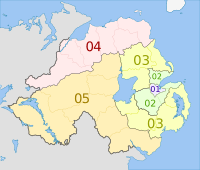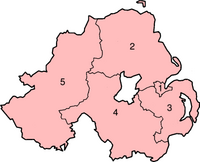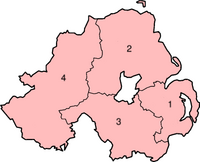Local government in Northern Ireland facts for kids
Northern Ireland has 11 local areas called districts. These districts are used for local government. Local councils in Northern Ireland do not do everything that councils in other parts of the United Kingdom do. For example, they are not in charge of schools, building roads, or housing.
However, they do help with many important things. These include collecting waste and recycling. They also provide fun activities and community services. Councils help with building rules and support local businesses and culture. While they don't plan new buildings, they are asked for their ideas on some plans. A special agency called Land and Property Services collects local taxes.
Contents
How Northern Ireland's Local Government Changed
The way Northern Ireland is divided into 11 local districts started on April 1, 2015. This change was part of a big plan to improve local government. This plan began back in 2005.
Before 2015, Northern Ireland had 26 local councils. This system was set up in 1973. It replaced an even older system from 1898. From 1921 to 1973, Northern Ireland had six main areas called administrative counties. These counties were split into smaller urban and rural districts.
How Local Councillors Are Chosen
Local councillors are people elected to represent their district. They serve for four years. They are chosen using a special voting system called single transferable vote (STV). The last elections were held in May 2014.
To become a councillor, a person must meet certain rules:
- They must be at least 18 years old.
- They must be a citizen of a Commonwealth of Nations country or the European Union.
- They must also live, work, or own land in the district they want to represent. This must have been true for the 12 months before the election.
How Districts Work Together
The local districts in Northern Ireland also work together for different purposes.
Eurostat NUTS Areas
Eurostat is a group that collects statistics for Europe. They divide Northern Ireland into five larger areas for their statistics. These areas are called NUTS level 3 regions.
| Name | Area | ||
|---|---|---|---|
| UKN01 | Belfast | ||
| UKN02 | Outer Belfast | Carrickfergus, Castlereagh, Lisburn, Newtownabbey, North Down | |
| UKN03 | East | Antrim, Ards, Ballymena, Banbridge, Craigavon, Down, Larne | |
| UKN04 | North | Ballymoney, Coleraine, Derry, Limavady, Moyle, Strabane | |
| UKN05 | West and South | Armagh, Cookstown, Dungannon, Fermanagh, Magherafelt, Newry and Mourne, Omagh |
Past Education and Library Boards
Northern Ireland used to have five education and library boards (ELBs). These boards managed schools and libraries.
In April 2009, a new group called Libraries NI took over all the library services. Then, in April 2015, all the education tasks were put under one new group. This group is called the Education Authority for Northern Ireland.
The old boards were:
| Name | Area | ||
|---|---|---|---|
| 1. | Belfast | ||
| 2. | North Eastern | Antrim, Ballymena, Ballymoney, Carrickfergus, Coleraine, Larne, Magherafelt, Moyle, Newtownabbey | |
| 3. | South Eastern | Ards, Castlereagh, Down, Lisburn and North Down | |
| 4. | Southern | Armagh, Banbridge, Cookstown, Craigavon, Dungannon and South Tyrone, Newry and Mourne | |
| 5. | Western | Derry, Fermanagh, Limavady, Omagh, Strabane |
Past Health and Social Services Boards
There were also four health and social services boards in Northern Ireland. These boards were replaced by one single board in April 2009. This new board is called the Health and Social Care Board.
The old health and social services boards were:
| Name | Area | ||
|---|---|---|---|
| 1. | Eastern | Ards, Belfast, Castlereagh, Down, Lisburn, North Down | |
| 2. | Northern | Antrim, Ballymena, Ballymoney, Carrickfergus, Coleraine, Cookstown, Larne, Magherafelt, Moyle, Newtownabbey | |
| 3. | Southern | Armagh, Banbridge, Craigavon, Dungannon and South Tyrone, Newry and Mourne | |
| 4. | Western | Derry, Fermanagh, Limavady, Omagh, Strabane |
Changes to Local Government
In 2002, the Northern Ireland Executive started a review to see how public services were managed. One idea was to have fewer local districts. In 2005, a plan was announced to reduce the number of councils to seven. The new names and areas for these seven districts were shared in 2007.
However, in 2008, the Northern Executive decided to create eleven new councils instead of seven. The first elections for these new councils were supposed to happen in May 2011. But disagreements about the district borders caused delays. In 2010, the plans were put on hold. Finally, in March 2012, the Northern Ireland Executive confirmed they would reduce the number of councils to 11.
See also
In Spanish: Organización territorial de Irlanda del Norte para niños




